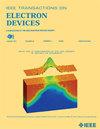Characterization Methods of TMD Transistor Gate Dielectrics Targeting 1 nm EOT for 2-D CMOS Scaling
IF 3.2
2区 工程技术
Q2 ENGINEERING, ELECTRICAL & ELECTRONIC
引用次数: 0
Abstract
2-D materials show promise to possibly replace Si channel material to continue Moore’s Law scaling of transistors down to 5 nm gate lengths. The scaling opportunities of 2-D materials arise due to their ultra-thin monolayer thickness of sub-1 nm, which allows for strong electrostatic gate control while maintaining high mobility with virtually no surface roughness scattering from the intrinsically passivated van der Waals (vdW) surfaces. The scaling benefits of 2-D materials, however, can only be realized with the development of a highly scaled, low-defect gate oxide growth method compatible with vdW surfaces. This has thus far proven to be challenging as the vdW surfaces lack the dangling bonds required for standard ALD oxide growth nucleation. Furthermore, gate oxide films grown on vdW surfaces are rarely characterized following industry standard capacitance–voltage (CV) methods, primarily due to high leakage or resistance often present in today’s 2-D transistors, rendering CV measurements very difficult. While 2-D MOSFET gate leakage and contact resistances are improving rapidly, researchers still resort to inferring equivalent oxide thickness (EOT) from I–V characterization rather than standard CV. In this work, we show through both technology computer aided design (TCAD) simulations and experiments that I–V based methods of 2-D MOSFET EOT measurements have several pitfalls which may lead to inaccurate conclusions. We provide techniques to improve accuracy for both I–V and CV-based gate oxide characterization, which will help accelerate the field of 2-D transistor development closer toward a feasible CMOS technology.面向1nm EOT的二维CMOS标化TMD晶体管栅极介质的表征方法
二维材料有望取代硅沟道材料,继续按照摩尔定律将晶体管缩小到5纳米栅极长度。二维材料的结垢机会来自于其低于1nm的超薄单层厚度,这允许强大的静电栅极控制,同时保持高迁移率,几乎没有本质钝化范德华(vdW)表面的表面粗糙度散射。然而,二维材料的缩放优势只能通过开发一种与vdW表面兼容的高缩放、低缺陷的栅氧化生长方法来实现。到目前为止,这已被证明是具有挑战性的,因为vdW表面缺乏标准ALD氧化物生长成核所需的悬空键。此外,在vdW表面生长的栅极氧化膜很少按照工业标准的电容电压(CV)方法进行表征,主要是由于今天的二维晶体管中经常存在高泄漏或电阻,使得CV测量非常困难。虽然二维MOSFET栅极漏电和接触电阻正在迅速改善,但研究人员仍然依靠从I-V表征而不是标准CV来推断等效氧化物厚度(EOT)。在这项工作中,我们通过计算机辅助设计(TCAD)模拟和实验表明,基于I-V的二维MOSFET EOT测量方法存在几个缺陷,可能导致不准确的结论。我们提供的技术可以提高基于I-V和cv的栅极氧化物表征的准确性,这将有助于加速二维晶体管领域向可行的CMOS技术发展。
本文章由计算机程序翻译,如有差异,请以英文原文为准。
求助全文
约1分钟内获得全文
求助全文
来源期刊

IEEE Transactions on Electron Devices
工程技术-工程:电子与电气
CiteScore
5.80
自引率
16.10%
发文量
937
审稿时长
3.8 months
期刊介绍:
IEEE Transactions on Electron Devices publishes original and significant contributions relating to the theory, modeling, design, performance and reliability of electron and ion integrated circuit devices and interconnects, involving insulators, metals, organic materials, micro-plasmas, semiconductors, quantum-effect structures, vacuum devices, and emerging materials with applications in bioelectronics, biomedical electronics, computation, communications, displays, microelectromechanics, imaging, micro-actuators, nanoelectronics, optoelectronics, photovoltaics, power ICs and micro-sensors. Tutorial and review papers on these subjects are also published and occasional special issues appear to present a collection of papers which treat particular areas in more depth and breadth.
 求助内容:
求助内容: 应助结果提醒方式:
应助结果提醒方式:


